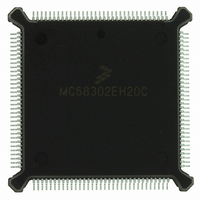MC68302EH20C Freescale Semiconductor, MC68302EH20C Datasheet - Page 397

MC68302EH20C
Manufacturer Part Number
MC68302EH20C
Description
IC MPU MULTI-PROTOCOL 132-PQFP
Manufacturer
Freescale Semiconductor
Datasheets
1.MC68302AG20C.pdf
(4 pages)
2.MC68302AG20C.pdf
(2 pages)
3.MC68302AG20C.pdf
(13 pages)
4.MC68302EH20C.pdf
(481 pages)
Specifications of MC68302EH20C
Processor Type
M683xx 32-Bit
Speed
20MHz
Voltage
5V
Mounting Type
Surface Mount
Package / Case
132-MQFP, 132-PQFP
Family Name
M68000
Device Core
ColdFire
Device Core Size
32b
Frequency (max)
20MHz
Instruction Set Architecture
RISC
Supply Voltage 1 (typ)
5V
Operating Temp Range
0C to 70C
Operating Temperature Classification
Commercial
Mounting
Surface Mount
Pin Count
132
Package Type
PQFP
Lead Free Status / RoHS Status
Lead free / RoHS Compliant
Features
-
Lead Free Status / Rohs Status
Compliant
Available stocks
Company
Part Number
Manufacturer
Quantity
Price
Company:
Part Number:
MC68302EH20C
Manufacturer:
Freescale Semiconductor
Quantity:
10 000
Part Number:
MC68302EH20C
Manufacturer:
FREESCALE
Quantity:
20 000
Company:
Part Number:
MC68302EH20CB1
Manufacturer:
Freescale Semiconductor
Quantity:
10 000
Company:
Part Number:
MC68302EH20CR2
Manufacturer:
Freescale Semiconductor
Quantity:
10 000
- MC68302AG20C PDF datasheet
- MC68302AG20C PDF datasheet #2
- MC68302AG20C PDF datasheet #3
- MC68302EH20C PDF datasheet #4
- Current page: 397 of 481
- Download datasheet (2Mb)
SCCs on the MC68302 can do this very efficiently because of their sophisticated DMA ca-
pability, and very little MC68000 core intervention is required.
Third, some applications require the switching of data without interfering with the protocol
encoding itself. For instance, in a multiplexer, data from a high-speed time-multiplexed serial
stream is multiplexed into multiple low-speed data streams. In this case, the idea is to switch
the data path but not alter the protocol encoded on that data path.
Finally, some applications require a special protocol that does not fall under the category of
HDLC, UART, etc. In some instances, transparent mode can be used; however, care should
be taken to understand the capabilities of transparent mode before trying this. The most im-
portant issue is how this new protocol recognizes its frames on the receiving end. Transpar-
ent mode on the MC68302 was designed to work well receiving continuous streams of data
(no gaps in the data exist over time). This is different from receiving transparent frames; al-
though there is some support for this, it is limited on the MC68302.
D.8.3 Physical Interface to Accompany Transparent Mode
Before discussing the details of transparent mode timing, we need to chose the physical in-
terface to go with the transparent mode. The timings associated with transparent mode differ
based on the physical interface chosen.
The MC68302 supports the following four physical interfaces:
You will probably chose either an NMSI or PCM highway interface, unless you are designing
an ISDN-based system. If you are designing an ISDN-based system, you will probably
choose either an IDL or GCI interface. The following paragraphs discuss all the interfaces,
but special attention is given to the NMSI.
The most commonly used physical interface on the MC68302 is the nonmultiplexed serial
interface (NMSI). The NMSI consists of seven basic modem (RS-232) signals: TXD, TCLK,
RXD, RCLK, RTS, CTS, and CD. Each of the three SCCs can have its own set of these sig-
nals, as shown in Figure D-21.
MOTOROLA
• Nonmultiplexed Serial Interface—NMSI
• Pulse Code Modulation Highway—PCM
• Interchip Digital Link—IDL
• General Circuit Interface—GCI
The following discussion assumes some knowledge of the inter-
faces. For more applications information on these interfaces, re-
fer to 4.4 Serial Channels Physical Interface.
MC68302 USER’S MANUAL
NOTE
MC68302 Applications
D-47
Related parts for MC68302EH20C
Image
Part Number
Description
Manufacturer
Datasheet
Request
R
Part Number:
Description:
Manufacturer:
Freescale Semiconductor, Inc
Datasheet:

Part Number:
Description:
MC68302 Configuring the Chip Selects on the MC68302
Manufacturer:
Motorola / Freescale Semiconductor

Part Number:
Description:
MC68302 Design Concept - Expanding Interrupts on the MC68302
Manufacturer:
Motorola / Freescale Semiconductor

Part Number:
Description:
MC68302 MC68302 Adapting a WAN Controller to a LAN Environment
Manufacturer:
Motorola / Freescale Semiconductor

Part Number:
Description:
MC68302 EKB Applications - Power Measurements on the MC68302
Manufacturer:
Motorola / Freescale Semiconductor

Part Number:
Description:
MC68302 Interfacing the MC68020 to a Slave MC68302
Manufacturer:
Motorola / Freescale Semiconductor

Part Number:
Description:
MC68302 MC68302 Software Performance
Manufacturer:
Motorola / Freescale Semiconductor

Part Number:
Description:
MC68302 Evaluating EDX on the ADS302
Manufacturer:
Motorola / Freescale Semiconductor

Part Number:
Description:
MC68302 Design Advisory #1 - MC68SC302 Passive ISDN Protocol Engine
Manufacturer:
Motorola / Freescale Semiconductor

Part Number:
Description:
MC68302, MC68360, and MPC860 Characteristics and Design Notes for Crystal Feedback Oscillators
Manufacturer:
Motorola / Freescale Semiconductor
Part Number:
Description:
Mc68302 Integrated Multi-protocol Processor
Manufacturer:
Freescale Semiconductor, Inc
Datasheet:
Part Number:
Description:
Manufacturer:
Freescale Semiconductor, Inc
Datasheet:
Part Number:
Description:
Manufacturer:
Freescale Semiconductor, Inc
Datasheet:
Part Number:
Description:
Manufacturer:
Freescale Semiconductor, Inc
Datasheet:
Part Number:
Description:
Manufacturer:
Freescale Semiconductor, Inc
Datasheet:











